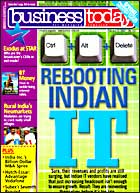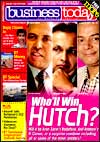 |
| Size matters: Over
the next three years, an estimated $50-billion worth of drugs
will go off patent. And to tap this opportunity, Indian companies
need to consolidate |
If Indian generic players
needed proof that they had become a royal pain in Big Pharma's neck,
then they couldn't have asked for a more telling (or amusing) testimony.
Stepping down as CEO recently, but retaining his Chairman's title,
Jean-Francois Dehecq of the world's #3 drug maker Sanofi-Aventis
lashed out at pharma companies in developing countries, calling
their strategy of selling cut-price generics in developed markets
a "scandal". "They make drugs very cheaply and bring
them to the north for people who can already pay," he complained
to The Financial Times in an interview. "It's a scandal. They
are exploiting people in the south. They should deal with their
own countries first."
Well, good morning, Monsieur Dehecq. Welcome to the new world
order in pharma, where generics, or cheaper copies of branded
drugs, is the name of the game. It's easy to see why Big Pharma
companies like Sanofi-Aventis consider generic manufacturers as
their Enemy #1. For about 10 years now, the number of new drugs
coming out of the labs of Big Pharma has been steadily declining,
even as the real spend on research and development (R&D) has
almost doubled from about $17 billion to $36 billion at last count.
As a result, there are fewer blockbuster drugs (those fetching
more than $1 billion in annual revenues) hitting pharmacies and
Big Pharma growth is stalling. Simultaneously, industry regulations
have become far more stringent, raising the amount of time and
money drug makers spend on developing drugs, even as consumers
and courts get far less tolerant of faulty drugs. Result: Drug
giants Pfizer and Merck alone have lost billions of dollars in
combined market cap since 2000.
In contrast, the generic manufacturers have been booming. Take
India, for example. Early 2000, the largest Indian drug maker,
Ranbaxy Laboratories, had generic exports of Rs 1,209.6 crore.
Today, 79 per cent of its revenues, or Rs 4,795.30 crore, come
from international operations, most of which is generic-driven.
On the whole, generic drugs have increased their share in global
markets from 8-10 per cent three-four years ago to 12-14 per cent
now. Over the next three years (2007-09), some $50-billion worth
of generics will go off patent, creating a huge market for generic
drugs. Indian players, who have the twin advantage of low-cost
manufacturing and research, are among the best placed to tap this
opportunity.
Bulking Up
Yet, things aren't as straightforward. Perhaps the biggest problem
that Indian generic manufacturers face is of size. Compared to
the biggest generic player in the world, Teva-ivax, the biggest
Indian player Ranbaxy is less than one-fifth in size at Rs 6,070
crore. In this business, heft matters, particularly since the
front-end-that is, distribution-is getting consolidated. That's
why there has been a rash of mergers and acquisitions in the generic
space. IVAX, for instance, was a separate American company until
July 2005, when Israel's Teva acquired it for $7.4 billion. Earlier,
Novartis had jumped to the #1 position when its generic arm Sandoz
made two acquisitions (Eon Labs and Hexal) earlier in the same
year.
Among the Indian generic companies, Ranbaxy has been the most
active, making six acquisitions in markets outside India such
as the US and Europe in 2006 alone. According to recent reports,
it is mulling its most ambitious acquisition bid yet in the form
of Merck's generic business. It will cost Ranbaxy upwards of $5
billion (Rs 22,500 crore)-more than three times its revenues-but
catapult it to the #3 position behind Teva and Sandoz. "The
generic business of Merck is a quality asset," says Ranbaxy's
CEO & MD, Malvinder Singh. "It offers a strategic fit
to our business and we would certainly be interested if it is
available at the right price and enhances shareholder value,"
he adds.
It's not just Ranbaxy that's talking M&A. Smaller rivals,
including Sun Pharmaceuticals, Nicholas Piramal, and Wockhardt,
too have cherry-picked opportunities abroad. Wockhardt, for instance,
has made four acquisitions in Europe (two in the UK, and one each
in Germany and Ireland) for $190 million. Bigger players like
Hyderabad-based Dr Reddy's Labs have also landed some big catch
such as Germany's betapharm, which incidentally is the biggest
pharma acquisition by an Indian company. Dr Reddy's is not ruling
out further acquisitions to accelerate its global ramp-up. "Scale
is becoming important because the R&D spend, if leveraged
over a much higher amount of revenues and market share, becomes
that much more affordable," says G.V. Prasad, Executive Vice
Chairman and CEO, Dr Reddy's Labs.
The need to scale up arises from multiple factors, but everything
links back to the changing competitive landscape. There was a
time when the innovator companies (that is, those that own the
patented drug) would sneeze at the flea-market business of generics.
It was below them to get into a market where generic copies got
sold for a fraction of the branded drug. However, their own dwindling
pipeline of new drugs has forced them to either 'authorise' manufacture
of generics by a Teva or Sandoz or to launch their own generic
copies. With the result, generic prices in the US have come crashing
down. Today, it's not unusual for a copy-cat drug to sell at just
5 per cent of the innovator drug price. What it means is that
while $50-60-billion worth of drugs may be going off patent in
the next three-to-five years, the actually opportunity is vastly
smaller.
Understandably, that has heightened competition among the pure
generic companies. It's not enough anymore to come up with a generic
drug, but you must also be the first to file for the right to
sell it and, ideally, challenge and win some of the existing patents
of the innovator's drug. That has driven through the roof the
cost of such exclusive generics, since the aspirant must not only
battle the innovator company but also rival generic manufacturers.
Even then, the risk of the innovator and a generic rival striking
a deal for authorised generics remains. Says Dilip Shanghvi, CMD,
Sun Pharma: "With new entrants, who have a different cost
structure, preparing to enter the us market, we do not think prices
are likely to stabilise as yet."
Market Diversification
Then, there's another problem with the US market. While Indian
companies file the largest number of applications for generics
(called ANDAS, or Abbreviated New Drug Applications), few of them
are patent-challenging. That means most of the launches are destined
to compete in the 'commodity' market, where both prices and profits
are wafer-thin.
One way the Indian manufacturers have tried to beat the profit
pressure is by diversifying into other markets such as Europe
(see Europe is Promising...). Here, key markets like Germany and
France are growing in value terms between 6 and 20 per cent annually,
creating new opportunities. However, the governments here seem
more inclined to control prices of drugs to keep medicare costs
low. That's one reason why some analysts say, in retrospect, that
companies like Dr Reddy's may have overpaid for their European
acquisitions.
Needless to say, Indian drug makers will recalibrate their expectations,
but persist in the European markets. At the same time, the US
will remain their holy grail. No doubt, generic prices are under
pressure, but the demand for them is growing. In fact, factors
such as the Medicare Modernisation Act and an ageing population
are encouraging the move towards cheaper generics, and it is expected
that by 2010, the share of generics could account for 70 per cent
of all prescriptions dispensed in the us, up from around 55 to
60 per cent at present (in value terms, the share is, however,
just around 15 per cent today and this could marginally increase
by 2010). Says Sun's Shanghvi, who owns a manufacturing unit in
the us: "We continue to be primarily focussed on the us because
it is still the largest market and we would want to get to a certain
size there."
The road ahead will be trickier to negotiate. Until recently,
few of the Big Pharma companies or generic giants were tapping
the low-cost manufacturing or research opportunities in India.
But now they have realised the need to do so. Teva has a captive
bulk drug plant in India; Mylan Laboratories of the us coughed
up $736 million last August to buy Hyderabad-based Matrix Laboratories
to get access to low-cost bulk drugs and formulations. Chinese
manufacturers, who still don't have any significant presence in
the global market for generic drugs, are aggressive players in
bulk drugs. That puts pressure on vertically integrated Indian
companies such as Ranbaxy and Dr Reddy's to find ways of cutting
costs further.
Some of the solutions that such players have come up with include
spinning off their capital-intensive R&D activities into separate
entities. But as Ranbaxy's Singh seems to have realised, the time
now is for bold moves. Indeed, scale up or ship out may be the
new reality in Indian pharma.
|





